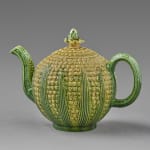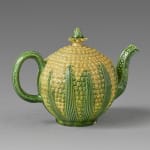

A Fine and Rare Staffordshire ‘Whieldon Type’ Pineapple Teapot and Cover, Circa 1760
A Fine and Very Rare Staffordshire ‘Whieldon Type’ Pineapple Teapot and Cover, the globular form body is press-moulded with pineapple ‘meat’ relief decoration, enhanced with ribbed pointed leaves. The body is lead glazed in yellow while the leaves, footrim, moulded stylised loop handle, and hexagonal-faceted spout with moulded decoration are a striking green. The cover continues the moulded pineapple ‘meat’ decoration with a green glazed flower-head finial.
Between 1754 and 1759, Josiah Wedgwood (1730-1795) worked with his partner Thomas Whieldon (1719-1795) in Fenton, Staffordshire where tablewares were produced in naturalistic designs modelled after cauliflower and pineapple using vibrant glaze decoration.
In the eighteenth century, pineapple was a rare and fashionable luxury found on the dining table but also inspiring the arts where it was used as a decorative motif in paintings, furniture, architecture, and ceramics. Merchants were able to rent out pineapples as they were so desirable and expensive.
The pineapple design is also attributed to the potter William Greatbatch (1735-1813), based on a waster found at the William Greatbatch factory site, Fenton.
Excavated sherds in America demonstrate the demand and export of these wares to the American colonies.
See a similar example in the British Museum, London (1923,0122.59.CR)
Literature
See a similar example and discussion in Leslie B. Grigsby, The Henry H. Weldon Collection, English Pottery, Stoneware and Earthenware 1650-1800, London, 1990, p. 192.
See further discussion in Lisa Hudgins, ‘Staffordshire in America: The Wares of John Bartlam at Cain Hoy, 1765–1770’, Ceramics in America (2009), 68-80.
Join our mailing list
* denotes required fields
We will process the personal data you have supplied in accordance with our privacy policy (available on request). You can unsubscribe or change your preferences at any time by clicking the link in our emails.

